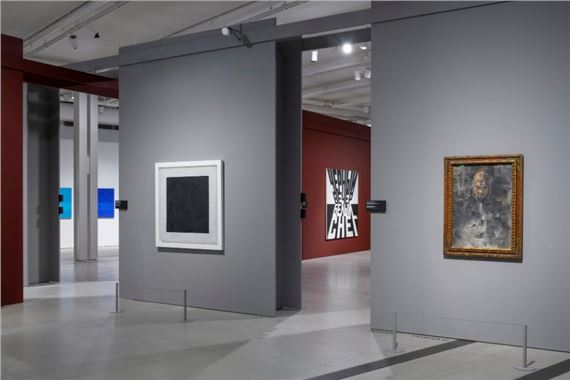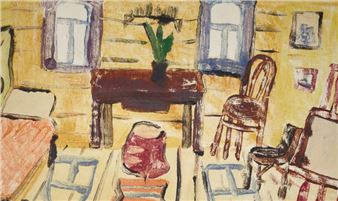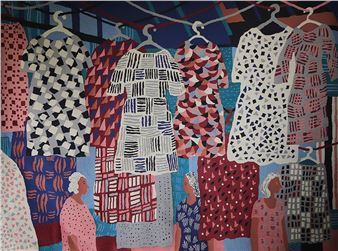Square And Space: From Malevich To GES-2
In Square and Space, two stories unfold in parallel. The first is about how the creative space spills out from a small square canvas to fill a building the size of the House of Culture. The second story, even more important, is that of the relation between the work of art and the viewer over the last century and a half, during which masterpieces ceased to play the leading role. Displaced from the centre of attention to the periphery, they have become optional backgrounds for self-assertion, frames for selfies.
Unlike the Russian kvadrat, the English word вҖңsquareвҖқ has two meaningsвҖ”one geometric, the other urbanistic. With the invention of the QR code, the geometric squareвҖ”the most celebrated version of which in art is undoubtedly Kazimir MalevichвҖҷs Black SquareвҖ”has come to contain vast amounts of information (вҖңinfinite and eternal,вҖқ as Malevich said of his canvas, which, in fact, is far from black, and not, strictly speaking, a square). The urban square, on the other hand, has only become more emptied with the passing of time, due, in part, to the preference of our contemporaries for online communication, at home on their smartphones.
Square and Space unites these two meanings of the word вҖңsquare,вҖқ inviting visitors to observe how the canvas that heralded the end of painting more than a hundred years ago came, paradoxically, to serve as a stimulus for further artistic discoveries. A stroll through the twelve sections of this exhibition provides an opportunity to see how colour and light, form and construction, representations of the city and of man in the art of the past and the present were transformedвҖ”directly or indirectlyвҖ”by a single small black square on a white background, and how, in parallel, art was transformed from a quadrangle on a wall into an installation space that draws viewers in.

Recommended for you
In Square and Space, two stories unfold in parallel. The first is about how the creative space spills out from a small square canvas to fill a building the size of the House of Culture. The second story, even more important, is that of the relation between the work of art and the viewer over the last century and a half, during which masterpieces ceased to play the leading role. Displaced from the centre of attention to the periphery, they have become optional backgrounds for self-assertion, frames for selfies.
Unlike the Russian kvadrat, the English word вҖңsquareвҖқ has two meaningsвҖ”one geometric, the other urbanistic. With the invention of the QR code, the geometric squareвҖ”the most celebrated version of which in art is undoubtedly Kazimir MalevichвҖҷs Black SquareвҖ”has come to contain vast amounts of information (вҖңinfinite and eternal,вҖқ as Malevich said of his canvas, which, in fact, is far from black, and not, strictly speaking, a square). The urban square, on the other hand, has only become more emptied with the passing of time, due, in part, to the preference of our contemporaries for online communication, at home on their smartphones.
Square and Space unites these two meanings of the word вҖңsquare,вҖқ inviting visitors to observe how the canvas that heralded the end of painting more than a hundred years ago came, paradoxically, to serve as a stimulus for further artistic discoveries. A stroll through the twelve sections of this exhibition provides an opportunity to see how colour and light, form and construction, representations of the city and of man in the art of the past and the present were transformedвҖ”directly or indirectlyвҖ”by a single small black square on a white background, and how, in parallel, art was transformed from a quadrangle on a wall into an installation space that draws viewers in.
Artists on show
- Aleksandr Deyneka
- Aleksandr Mikhaylovich Rodchenko
- Alexander Khlebnikov
- Alexander Yulikov
- Alexandra Aleksandrovna Exster
- Andy Warhol
- Anna Zhyolud
- Anselm Kiefer
- Antony Gormley
- Arkhip Ivanovich Kuindzhi
- Boris Turetsky
- Candida Höfer
- Cy Twombly
- Dmitrij Aleksandrovich Prigov
- El Lissitzky
- Erik Bulatov
- Francis Bacon
- Francisco Infante
- Gerhard Richter
- Hermann Nitsch
- Igor Chelkovski
- Illarion Pryanishnikov
- Ilya & Emilia Kabakov
- Irina Nakhova
- Ivan Aivazovsky
- Ivan Chuikov
- Ivan Kliun
- Ivan Kudryashev
- Jasper Johns
- Jean-Michel Basquiat
- Jörg Immendorff
- Kazimir Malevich
- Konstantin Rozhdestvensky
- László Moholy-Nagy
- Laurence Sterne
- Leonid Chupyatov
- Lev Nussberg
- Lihi Turjeman
- Liu Guoqiang
- Ljubov Popova
- Maria Ender
- Meganom Studio
- Michelangelo Pistoletto
- Mikhail Chernyshev
- Mikhail Matiushin
- Mikhail Roginsky
- Mikhail VasilevichвҖҸ Le-Dantyu
- Nikita Alekseev
- Nikolai Mikhailovich Suetin
- Nikolai Punin
- Oleg Prokofiev
- Oleg Vassiliev
- Olga Vladimirovna Rozanova
- Pablo Picasso
- Prometei Construction Bureau
- Ralph Goings
- Rimma Zanevskaya-Sapgir
- Robert Fludd
- Roman Cherezov
- Rudolf Stingel
- Simon Faibisovich
- Sofía Dymshits Tolstaya
- Tatiana Andreeva
- Tatiana Badanina
- Thierry de Cordier
- Varvara Stepanova
- Vasily Shchetinin
- Victor Vasarely
- Vladimir Galkin
- Vladimir Marin
- Vladimir Seleznyov
- Vladimir Yakovlev
- Vladimir Yankilevsky
- Vyacheslav Koleichuk
- Wade Guyton
- Wassily Kandinsky
- Zaha Hadid

 ARTISTS
ARTISTS















